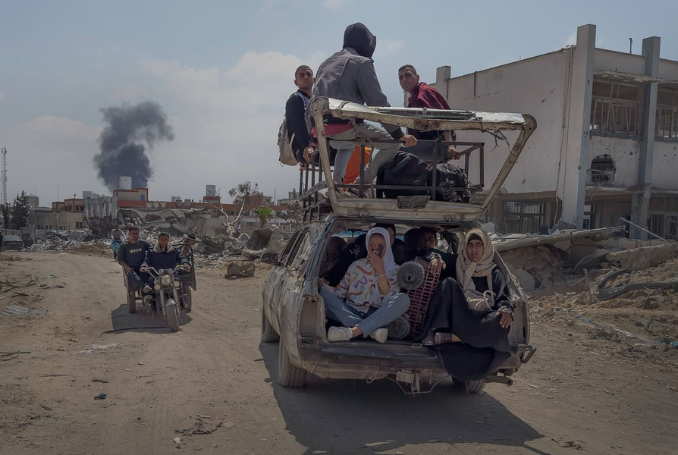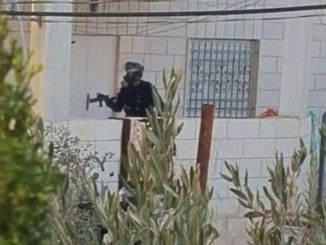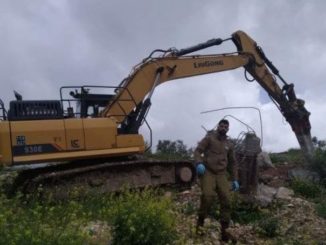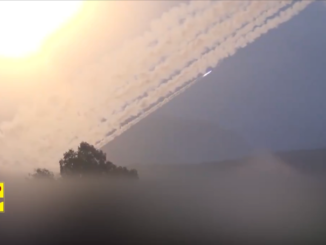
Around 150,000 Palestinians have fled parts of Khan Yunis in just one day, according to the United Nations.
This follows the evacuation order issued by Israeli forces and the “subsequent intensification of hostilities” in that area, Stephane Dujarric, the UN spokesperson told a press briefing on Tuesday.
“As assessed by humanitarian colleagues monitoring population movements in the area,” he said, “about 150,000 people fled areas in Khan Yunis” on Monday.
Dujarric said that the UN’s Office for the Coordination of Humanitarian Affairs (OCHA) expressed concern “about the short interval between the dropping of the leaflets telling people to leave and the escalation of military operations,” which posed significant risks to those fleeing.
“Just to give you an example, that delay was about an hour. Many have been observed on the move without any belongings,” he stressed.
Dujarric said the immediate escalation of hostilities in the area also resulted in many people being trapped in the evacuation area.
These included people with reduced mobility and family members supporting them, he explained.
‘Little or No Infrastructure’
“Each evacuation order profoundly disrupts people’s lives,” the UN spokesperson said, pointing out that people have been forced to move into areas with little or no infrastructure — where there is “very limited access to shelter, health, sanitation or other life-saving humanitarian assistance.”
The area designated for evacuation on Monday included two primary health centers and two medical points, as well as a dozen food distribution points and eight cooked meal provision points.
However, “These have all ceased operations, with only one community kitchen still operational for those who have remained behind,” he said.
‘Ten Out of 26 UN Health Centers Operational in Gaza’ – UNRWA
According to the World Health Organization (WHO), Dujarric said, the Nasser Hospital in Khan Younis has been forced to cope with an influx of patients, following the hostilities in the area.
Meanwhile, displacement also continues from the northern Gaza Strip southwards, as well as within and from the Al Bureij area of Deir al Balah, he said.
“Humanitarian workers’ ability to support the newly displaced is — of course and obviously — very limited,” he added.
UNICEF Vehicles Hit
Dujarric also highlighted that on Tuesday, “two clearly marked UNICEF (United Nations Children’s Fund) vehicles were hit with live ammunition while waiting at a designated holding point near the Wadi Gaza checkpoint.”
He explained that they were en route to reunite five children, including a baby, with their father.
‘Responsible Must Be Held Accountable’ – UN Convoy Targeted by Israeli Forces En Route to Gaza
“This is the second shooting incident involving UNICEF cars in the past 12 weeks. And of course, you will recall that UNRWA (United Nations Relief and Works Agency) suffered a similar incident on Sunday,” he added. “We strongly reiterate that humanitarian workers are protected under International Humanitarian Law and must never be targeted.”
Staggering Death Toll
Flouting a UN Security Council resolution demanding an immediate ceasefire, Israel has faced international condemnation amid its continued brutal offensive on Gaza.
Tel Aviv is currently on trial before the International Court of Justice for genocide against Palestinians.
According to Gaza’s Ministry of Health, 39,145 Palestinians have been killed, and 90,257 wounded. Moreover, at least 11,000 people are unaccounted for, presumed dead under the rubble of their homes throughout the Strip.
Israel says that 1,200 soldiers and civilians were killed during the Al-Aqsa Flood Operation on October 7. Israeli media published reports suggesting that many Israelis were killed on that day by ‘friendly fire’.
Palestinian and international organizations say that the majority of those killed and wounded are women and children.
The Israeli war has resulted in an acute famine, mostly in northern Gaza, resulting in the death of many Palestinians, mostly children.
The Israeli aggression has also resulted in the forceful displacement of nearly two million people from all over the Gaza Strip, with the vast majority of the displaced forced into the densely crowded southern city of Rafah near the border with Egypt – in what has become Palestine’s largest mass exodus since the 1948 Nakba.
Later in the war, hundreds of thousands of Palestinians began moving from the south to central Gaza in a constant search for safety.
(The Palestine Chronicle)









